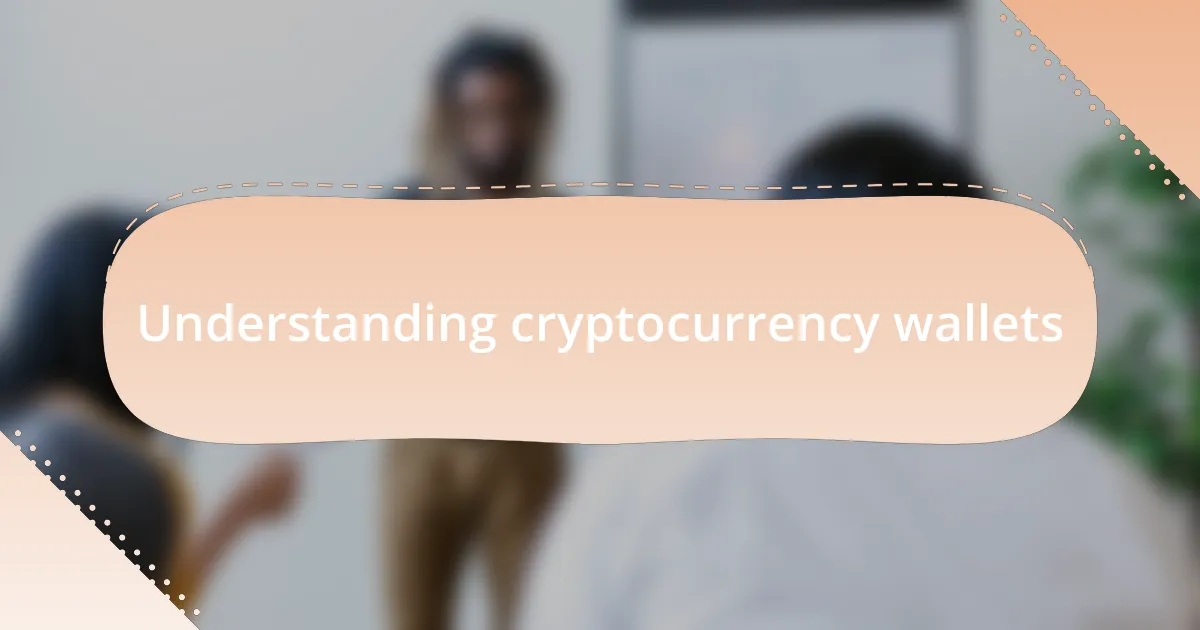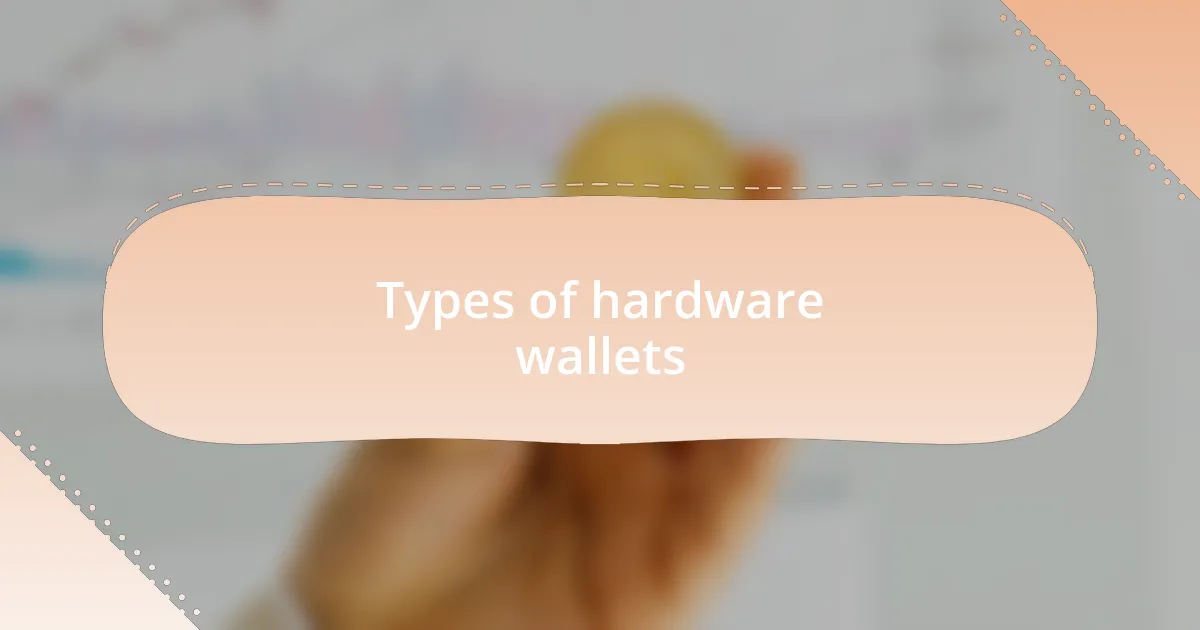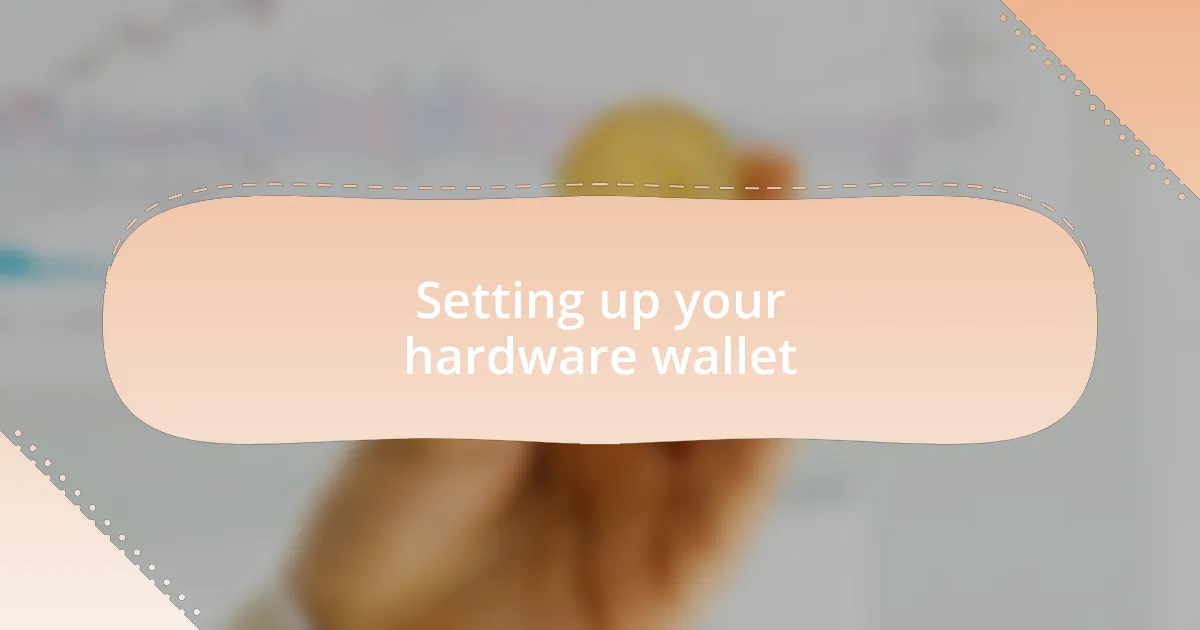Key takeaways:
- Understanding the differences between hot and cold wallets is vital for balancing security and convenience in cryptocurrency management.
- Choosing the right hardware wallet involves assessing personal needs, such as usability, multi-currency support, and additional security features.
- Regularly updating hardware wallet firmware is crucial for maintaining security and protecting digital assets.
- Securing and properly storing recovery phrases is essential to prevent loss of access to cryptocurrency funds.

Understanding cryptocurrency wallets
When I first delved into the world of cryptocurrency, I was overwhelmed by how different digital currencies were from traditional money. Just like a physical wallet keeps your cash and cards safe, a cryptocurrency wallet serves as the key to your digital assets. But, I often found myself wondering: how can something that seems so abstract really feel secure?
There are two main types of wallets: hot wallets and cold wallets. Hot wallets are connected to the internet, making them convenient for everyday transactions, while cold wallets, like hardware wallets, exist offline, adding an extra layer of security. I remember my initial hesitation in using a hardware wallet—would it really be as safe as everyone claimed? The peace of mind I gained from knowing my assets were stored in a physical device was worth it, and I’ve never looked back.
As I navigated through various wallets, I learned that each option has its unique advantages and drawbacks. Hot wallets are fantastic for accessibility, but I constantly worried about hacking risks. This led me to appreciate the balance between security and convenience—something every cryptocurrency holder needs to consider. Ultimately, understanding these wallets is essential; it’s like choosing the right fortress for your treasure.

Types of hardware wallets
When I started exploring hardware wallets, I quickly learned that there are different types tailored to various user needs. For example, some are USB devices, like the Ledger Nano S, which I personally found very straightforward to use. Others, like the Trezor Model T, come with a touchscreen that enhances user experience—but I couldn’t help but wonder: is the added functionality worth the investment?
Then, there are multi-currency wallets, which support a variety of cryptocurrencies. I recall the excitement of transferring not just Bitcoin, but also Ethereum and Litecoin all in one device. This versatility made me feel like a digital treasure hunter, exploring different assets without the hassle of juggling multiple wallets.
Lastly, there are more advanced models that offer additional security features, such as biometric authentication. While I haven’t personally ventured into these yet, the idea of using my fingerprint to access my funds intrigues me. I often think about the lengths I would go to secure my investments. As I assess these options, I realize that choosing the right hardware wallet is both a financial decision and a personal commitment to security.

Benefits of using hardware wallets
Using a hardware wallet has significantly enhanced my sense of security with cryptocurrency. Knowing my private keys are stored offline, away from the internet’s grasp, gives me peace of mind. Have you ever felt that weight lift when you finally secure something valuable? I definitely have—it’s liberating and reassuring.
Another notable benefit is the user control over my assets. With a hardware wallet, I’m not just relying on an exchange to keep my funds safe. Instead, I feel empowered, as if I’m the captain of my financial ship. When I first made the switch, I remember feeling a thrill; it was as if I had unlocked a hidden vault where my digital treasures were safeguarded.
Lastly, the ease of backup and recovery has been a lifesaver for me. Should anything go wrong, recovery phrases allow me to restore my wallet without a hitch. I often hear stories of others losing access to their funds due to system failures or forgotten credentials, which reinforces why I take proactive measures. What about you? Isn’t it reassuring to know that you have a fail-safe in place for your funds?

Setting up your hardware wallet
Setting up your hardware wallet is a straightforward yet crucial step in securing your cryptocurrency. The first thing I did after taking my wallet out of the box was to connect it to my computer. This simple action felt like opening a door to a new world; I was excited yet cautious about ensuring I followed every instruction meticulously.
As I began the setup process, I remember the moment my device prompted me to create a personal PIN. I felt a surge of responsibility—it was like being entrusted with a rare artifact. Choosing a strong PIN was important because this little number is the key to accessing all my assets. I often think about how easily some people overlook this step. Have you chosen a PIN that balances security and memorability for your own wallet?
After setting the PIN, I had to document my recovery phrase, which is a list of words used to restore my wallet if needed. I vividly recall the sense of urgency I felt while writing it down, making sure I wasn’t in a rush. Misplacing this phrase could mean losing access to my funds forever. It’s like being given a treasure map; without it, you might as well be searching in the dark for a treasure that could be elsewhere. Have you taken the time to securely store your recovery words? Trust me, this step is as essential as it gets.

Lessons learned from my journey
Lessons learned from my journey
One significant lesson I learned is the importance of regular firmware updates for my hardware wallet. Initially, I saw these updates as a mere inconvenience, interrupting my routine. However, when I discovered how they enhance security by patching vulnerabilities, I realized it was like giving my wallet a protective shield. I now prioritize these updates, understanding they are crucial for maintaining the integrity of my digital assets.
Another realization struck me during a panic-inducing moment when I couldn’t locate my recovery phrase. It was an eye-opener, making me face the reality of how essential this information really is. I ended up creating a secure, dedicated location for it, where I wouldn’t misplace it again. Have you thought about how you store yours? This experience taught me that peace of mind comes from knowing your recovery methods are foolproof.
Finally, I learned to view my hardware wallet as more than just a storage device; it’s a part of my financial journey. The emotional connection I developed was unexpected. While the numbers on my screen represent the potential for growth, I came to appreciate the responsibility that comes with managing these assets. Isn’t it interesting how we often forget that security and trust in our tools can enhance our overall experience?